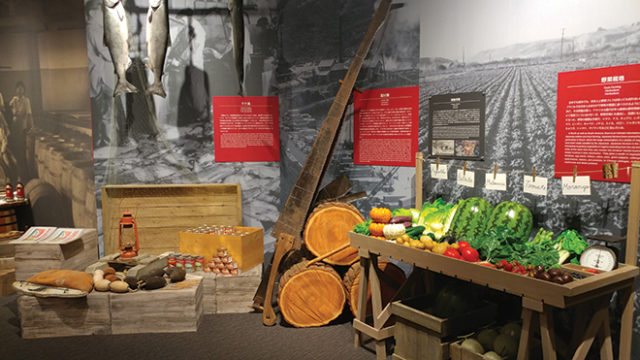By Stephanie Ikeda
In November, I visited the Japanese Overseas Emigration Museum for the first time. Located in the busy port area of Yokohama along with other tourist attractions, the modest but informative and engaging museum is a project of the Japan International Cooperation Agency (JICA) to promote greater understanding of Japanese overseas migration—in other words, the story of the Nikkei. The museum exhibits mainly discuss historic Japanese emigration to Hawai’i and the Americas. According to JICA researcher
Shigeru Kojima, most of the Nikkei who live in Japan are from South America, and therefore the story of Japanese Americans isn’t as visible in Japan.
When I visited the museum, I was pleasantly surprised at the prominence of displays featuring the Northwest Nikkei community. Upon entering the exhibit one of the first things visitors will see is a giant, life-size model of a vegetable and flower float made by the Yasui family in Portland, Oregon for the Rose Festival. The museum also has a large wall decal of Seattle’s Nippon Kan theater backdrop, the original of which is housed at the Wing Luke Museum today. A volunteer guide was happy to show me around the exhibits and explain various trivia about the hardships that the first immigrants faced in their new
countries, as well as events that greatly affected immigration to the U.S. such as the plantation labor pipeline and immigration laws. After my visit, I learned that documents about my greatgreat-uncle’s emigration to Brazil are held in the museum archives, which are viewable by appointment. I consider it one of many reasons to return next time I am in Japan.
A month after my visit, Mr. Kojima happened to visit Seattle to interview Japanese Americans about their personal or family experience with Japanese American exclusion during World War II. I was able to meet Mr. Kojima and sit in on his interview with Nobuko Ohgi, the niece of Genji Mihara. Mr. Kojima, like myself, wanted to know more about the experiences of Mr. Mihara, who was an Issei leader in Seattle for several decades after emigrating in 1907. Mr. Mihara was the first Japanese immigrant to receive the Second Order of the Sacred Treasure, a high-ranking civil honor from the Emperor of Japan, for his service to Japanese people in both the U.S. and Japan.

Mrs. Ohgi brought the or iginal medal received from the Emperor as well as sharing her memories of her uncle, whom she lived with on Mercer Island for 18 years. When Mr. Mihara passed away in 1982, he had dedicated his entire life to serving the Japanese
American community, a dedication so intense that it was said to have replaced his personal life. Mr. Mihara spoke about his unconstitutional arrest after Pearl Harbor at events and could give speeches at events with no script, but hardly ever spoke about his experiences at home. Mr. Kojima also filmed the exhibit and Nobuko’s memories of the objects and photographs within, and will hopefully be able to share it with Japanese audiences upon his return.
My visit to Yokohama and Mr. Kojima’s visit to Seattle have given me a great deal to process. As a fourth generation Japanese American, I can scarcely imagine what my ancestors sacrificed to come to the United States. However, the more I lear n about
others’ stories and meet others who are passionate about the history of our people, the closer I feel to them.







